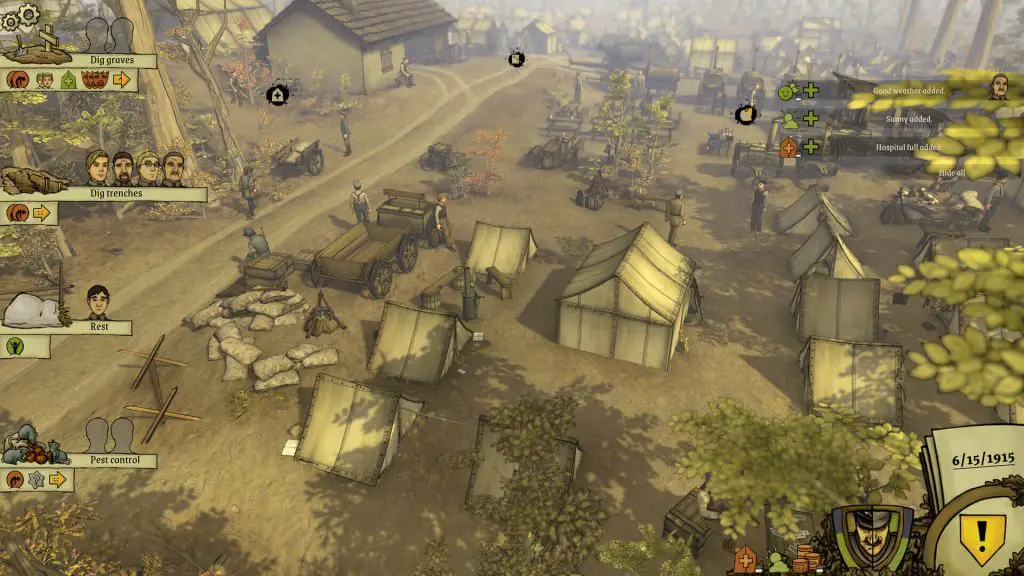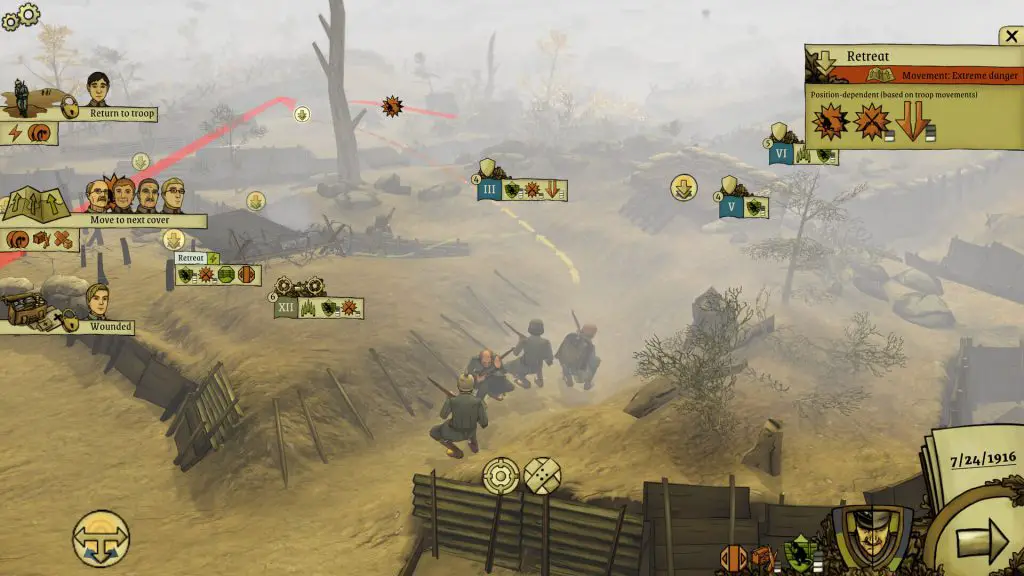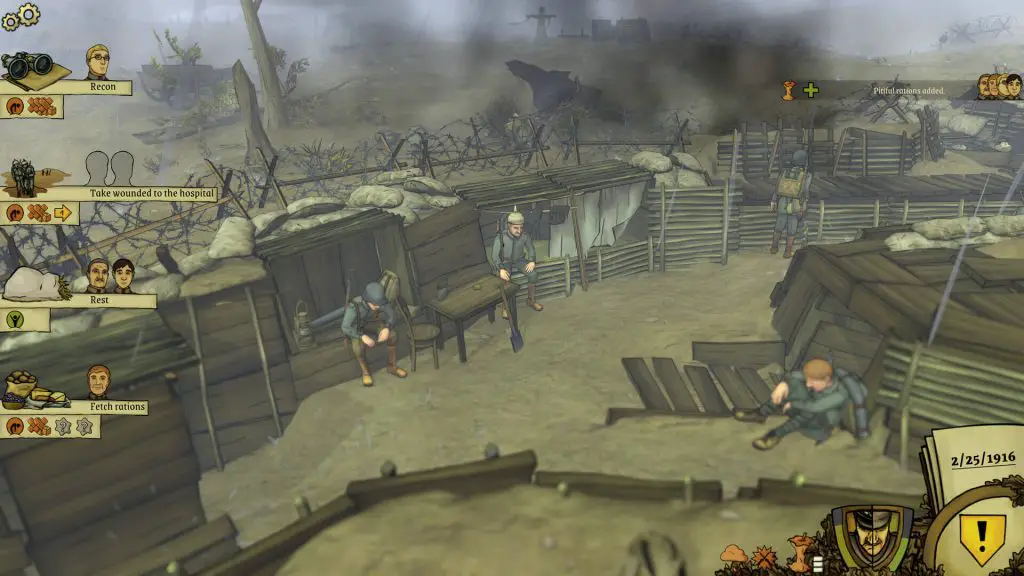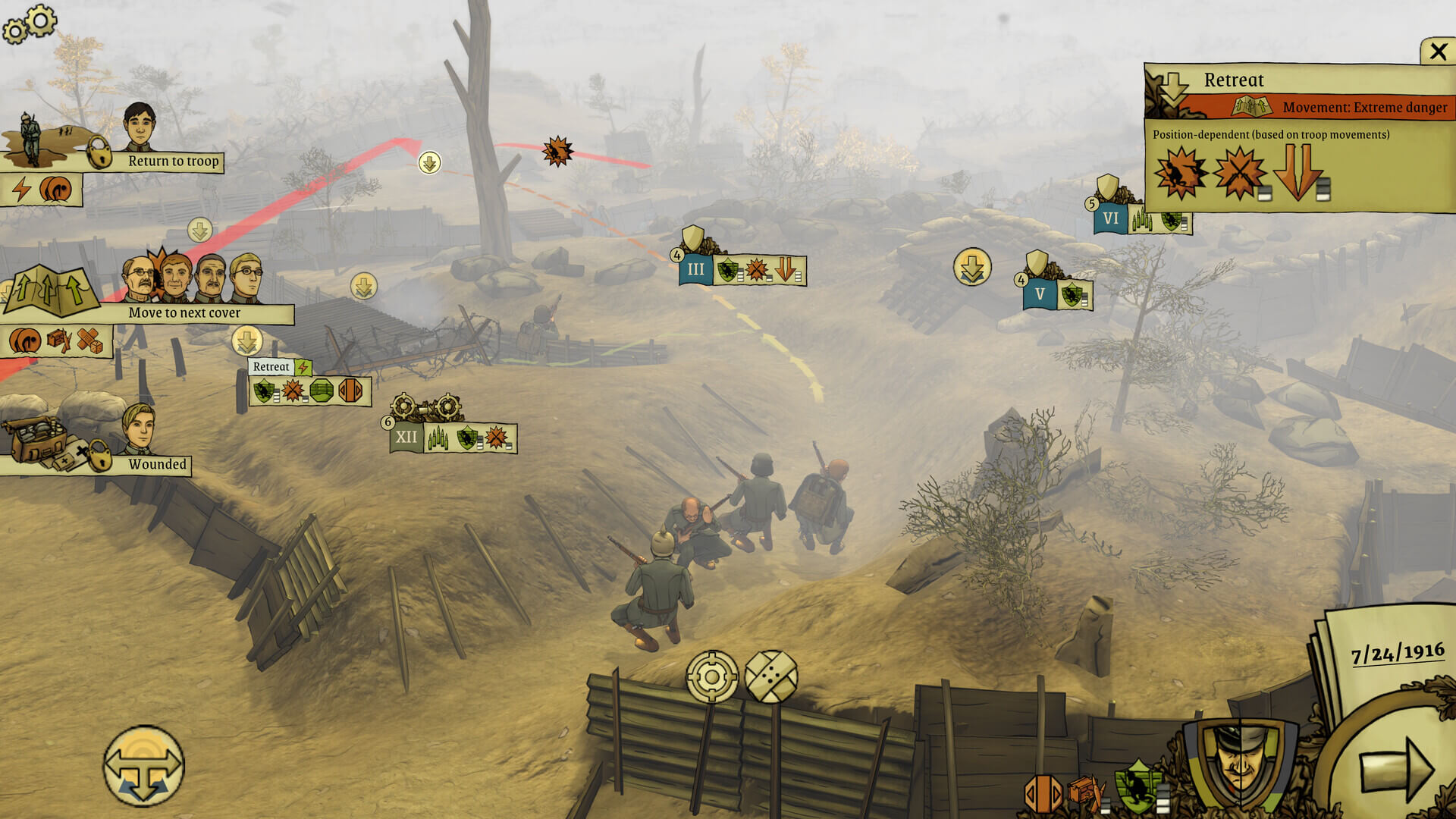All Quiet in the Trenches poses itself as a turn-based strategy game and survival game set in the trenches of World War 1, alternating between turn-based battle sequences and a management sim during the meat grinder that was the large offensives of the First World War. The demo is about an hour long and currently available on Steam.

Graphics & animations
All Quiet in The Trenches could use some touch-ups in its visual department. The animations are often fairly stiff, and 3D models look very wax statuesque when not moving, especially in the faces. When big battle scenes take place, it doesn’t have the same impact that a trench invasion should, since many of the models get stuck alternating between animation sequences or turning multiple times before deciding which way they wish to move.
Troop movements are also slow and seem to meander as they struggle to find their way around when listening to commands, and ultimately, look more like puppets struggling with pathfinding than true soldiers on a battlefield. There’s also a surprising lack of gore or gritty details aside from the odd body lying about, which is odd for a game set in World War 1. The rest of the graphical fidelity can be best described as basic and lacking any real visual flair, looking fairly basic and simple in its models and texturing.
The Combat System
The Turn-based combat is different from more traditional turn-based games. During Combat, Players can choose to relocate men to new positions or stay in cover and or fight in their current position. Players can move the camera to survey the battle taking place around them, showing multiple invading squads of the French pushing and pulling through the front lines against other friendly squads. Depending on how close the enemy is, player-controlled soldiers are at risk of being shot, fragged by grenades, or bayoneted, and chances of each are displayed to see.

Certain paths, when moving, also open up the players to be shelled by artillery or shot. In the demo, the player is assigned to scavenge for supplies, so players are deciding if it is better to stay in cover or assign soldiers to scout supplies at a location, all the while deciding when their squad should cut their losses and run. While the setup could create compelling decisions, I was more confused during the encounter than anything else.
When my soldiers were wounded, I was unsure how to heal them or if I could. I also don’t know how much the soldiers’ traits, such as being clumsy or a good shot, played a role in their performance. But the combat phase only took up a small portion of the demo, so it’s truly hard to gauge how compelling it would be, given I could have had more time with it.
One thing for certain is it definitely needs to work on its issues of clarity in conveying feedback, considering at one point, I was told I needed to provide cover fire for others fleeing the trenches. Still, I don’t know how much my little squad was contributing to the greater battle that was taking place around me.
Final Thoughts
So far, I have been pretty negative in my reception to All Quiet in the Trenches, and that’s mainly because I want many of the messier elements cleaned up before release because it’s the management side of the game that I came to love. At first, things are somewhat easy. You play as a squad leader and have been assigned your squad, as well what tasks to assign them to and set them to basics such as repairing the trenches after an artillery salvo or letting them rest and catch up on much-needed sleep.
However, this quickly becomes overwhelming. Soon, you need to fend off rats from the ration depot, helping to dig graves, and do extra chores around base camp. Your soldiers may even ask to take leave at a nearby pub. Some chores take priority over others, as forgetting to follow your higher-ups’ commands can bring his ire to your camp and bring consequences, but ignoring your squad’s wishes can lead to insubordination, which is shown as a balance players have to walk with meters in the bottom right.

Worst of all, you could work your men to exhaustion, which leaves you with even less manpower to utilize, leaving your whole group to suffer. Players will also find themselves having to manage the various personalities in your camp. Not everyone is going to get along, and tempers are short when everyone is suffering from a lack of sleep. You also have camp officers, such as a nurse, logistics officer, and more, who can assign extra work but can be used to call in favors such as bigger rations to help boost morale.
Ultimately, there’s too much to manage, and you will fail. You’ll have to make tough choices about whether you have the time to rescue a soldier buried in rubble or if you should feed your soldiers moldy rations when food is low. This creates a compelling narrative where your morals are questioned between being a good person or being a good commander and making decisions for the greater good. It wasn’t just the battles that killed men, but starvation, mutinies, and illness.
You’ll never have enough men to complete every task, and the consequences could be dire. So far in the demo, the most I’ve seen was having one of my soldiers collapse as well as having trouble maintaining discipline during the narrative moments between days, with some of my soldiers being unruly and refusing to salute me. But each day, I was dreading what happenstance would affect my soldiers and if they’d even have time to rest before the next big battle, but sadly, the demo cut off before I could see more.
Conclusion
All Quiet In the Trenches is a light recommendation so far. It’s definitely rough around the edges, but communicating with my men and listening to their conversations was always engaging and well-written, and using the camp mechanics and stress of the war to recreate the feeling of terror and dread of being not just a soldier, but an officer in charge of the lives of those under their command is incredible.
By the end of the demo I felt obligated to see out the war with all my men alive, Vaterland be damned! All Quiet in the Trenches releases January 17th, 2024.







